DIY water well: arrangement rules + analysis of 4 popular drilling methods
Providing a site with water is the first task of its owner. The grander plans to improve your territory, the more acute the lack of water supply will be felt. Water is needed for construction work, for the garden you are about to plant, and for your own daily needs.
If a well is made for water with their own hands, the dream of water supply will not only come true, but will also save significantly. We will tell you in what way it is better to drill and which projectile will be needed by independent craftsmen. Based on our advice, you can easily arrange your own water source on the site without any problems.
The content of the article:
The main types of water wells
There are several real ways to get life-giving moisture, which we will tell you about. There are several technologies that can be used for self-extraction of water in a suburban area.
You will have to choose the right option yourself, because it depends on the terrain, as well as on the technical equipment, finances and skills that you possess. Consider the main downhole structures.
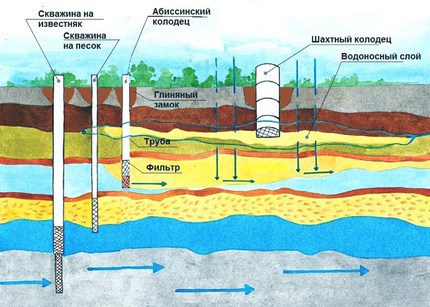
Tubular Abyssinian Well
If there is a spring on your site, then arranging a well is a great option for water production. The mine of this structure will play the role of a liquid accumulator. If the source is active enough, up to 2 cubic meters of water will always be at your disposal.
An Abyssinian well is essentially the same well, but narrow and long.Due to the fact that its length can be approximately 8-12 meters, pollution from the soil surface does not get into the water that fills it.
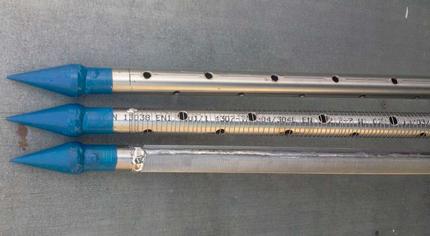
The following video will introduce the technology of punching and arrangement of a needle-hole, otherwise called the Abyssinian well,:
Well on the sand (filter)
Deepening of this design by 15-30 meters is carried out by any method: screw, shock-rope, core. The walls of the borehole are formed using a pipe with an average diameter of 100-180 mm.
The recessed end of the borehole is equipped with a filter. As a filter, a stainless steel mesh is used, which is welded or soldered to the first link of the pipe string before immersing it in coarse sand mixed with pebbles.
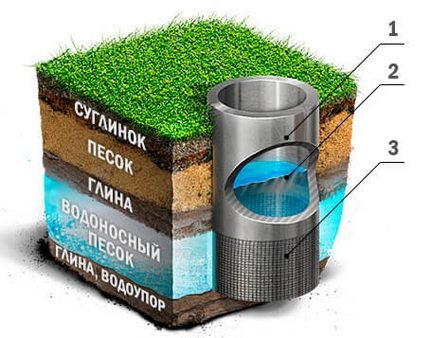
This design is able to meet the water demand of a small country house with two water points. If the operation of the structure is seasonal, it will last approximately five years. With constant use, you can count on 15 years of water supply.
When the well is still silted up, it will be possible to try to flush it. If resuscitation measures do not give the desired effect, you will have to drill a new trunk. They place it next to the previous one.
Artesian well without filter
This building does not need a filter. Such a well can reach a depth of 100 meters or more. Water produced by such a structure is contained in limestone cracks. The liquid accumulated in them due to condensation can be not only crystal clear, but also mineralized.
A little mineralization is acceptable for everyday use. If the produced water is among the mineral waters in its composition, then it cannot be used for domestic purposes.
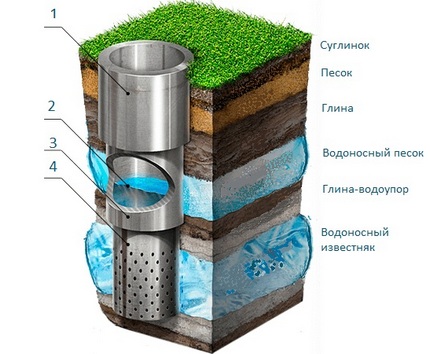
It is difficult to determine in advance the depth of the well that will have to be punched in search of water. You can only approximately orient yourself by talking with neighbors in the site and learning from them what parameters have similar structures in their territories.
The soil layers are uneven, so the information obtained can still not be considered accurate for your site. For this reason, casing is acquired taking into account the adjustment of the data.
How is a typical well arranged?
If you do not focus on the nuances, the essence of the device of the well for water for a country house is one: it is a long narrow vertical shaft, reaching a depth of water. The working walls are reinforced with casing pipes. Wells differ in width, depth and additional devices that increase their productivity and reliability.
In addition to the casing, the wells are equipped with equipment for forced lifting of the fluid and its distribution. To choose the right pumping equipment and storage capacity, you need to know the characteristics of the well, the most important of which is its depth and flow rate.
The flow rate of a well is an indicator of its productivity: the maximum volume of fluid produced per unit time. It is calculated in cubic meters or liters per hour or day.
Casing Functions
Casing pipes are the main element of the well. The casing is performed using separate pieces, welded, welded or screwed together. Particular attention should be paid to their equal diameter: the entire structure should create a straight, straight column.
If the casing has an external thread, the links are connected with couplings, due to which the diameter of the penetration increases.
Casing pipes are needed to:
- when drilling a well, the mine did not shed;
- the trunk is not clogged during its operation;
- the upper aquifers did not penetrate the structure.
Widely used casing pipes made of steel alloys and polymers (PVC, NPVH, PND). Less commonly used are cast-iron and obsolete asbestos-cement products. The space between the pipe and the earth around the mouth is poured with concrete if the mine was drilled in loose soils or the aquifer lies at a considerable depth.
Only after completing this work do all other equipment be installed. Sometimes during the operation of the well, a slight “extrusion” of the pipe to the surface may occur. This is a natural process that does not require any additional measures.
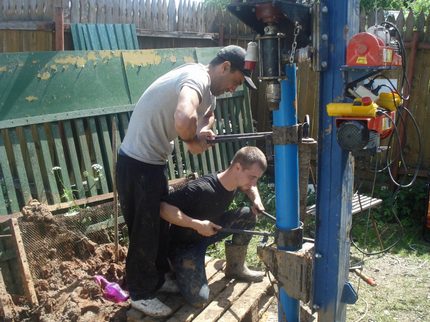
Inner pipe with filter
The double well casing is lowered into the wellbore filter pipe. Filtered water will flow through its perforated first link into the pipe, and then be removed to the surface by the pump.
After the pipe is installed at the desired depth, it is desirable to fix its mouth. For this purpose, use a clamp that does not allow spontaneous subsidence of the pipe.
Wellhead device
The upper part of the casing is equipped head-on. The basic design of this device is the same for heads of any kind. It consists of a flange, a cover and a rubber ring.
Different types of heads differ from each other by the type of material from which they are made, and by additional options.
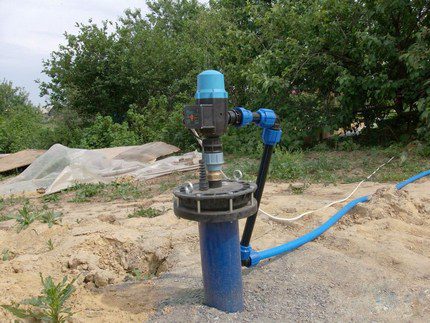
Due to the low pressure created by the head in the pipes, the flow of water increases and, as a result, the flow rate of the well.
Caisson, adapter, packer
So that increased humidity does not affect the operation of devices associated with the well, a special reservoir is provided for them - caisson. It is made of either metal or plastic.
Metal caissons, unlike plastic ones, can be repaired; they are better adapted to the climate with significant temperature differences. In addition, a metal product can be assembled independently from parts that are sold separately. But plastic models are cheaper and they do not rust.
Interested arrange a caisson for a well personally on our site will find detailed instructions for its construction.
To tightly connect the ground water and the well, you will need downhole adapter. This device is usually placed in the place where all the equipment that needs protection from water is assembled. Most often this is a technical room. One part of the adapter is attached to the casing, and the hose from the pump is screwed to the other part.
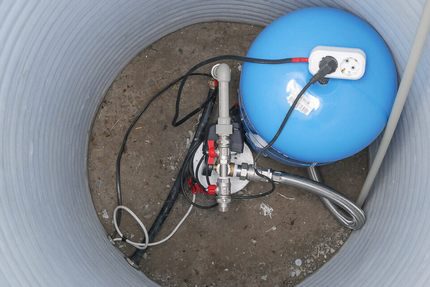
Sometimes there is a need to allocate a local section of a deep artesian well, on which, for example, repair work will be performed. For this purpose, and use packers - seals for wells.
The listed elements are part of the well device, having a great influence on its functionality.
Four types of drilling
You can drill a hole under the water with your own hands different ways, for the implementation of which both exclusively muscular efforts and technical means are used.
Consider the most popular types of drilling:
- auger;
- rotary;
- core;
- shock-rope.
Between themselves, these technologies differ in the methods of rock destruction during well construction and in the methods of extracting soil from the construction trunk to the surface. Different types of equipment are used to mine workings using various drilling methods, which affects the cost and quality of the finished structure.
Method # 1 - manual drilling
For manual drillingperformed by auger, shock-rope or combined technology, the following mechanisms and materials will be needed:
- Boer;
- winch;
- drill rig;
- rods;
- casing.
If the well, which is supposed to be built, will be deep enough, you need a drill tower. With the help of this design, the drill with the rods is immersed and its subsequent rise.
If the well is shallow, you can do without a tower. In this case, work with the drill is performed in manual mode.
The function of drill rods can perform narrow pipes, which are interconnected by means of threads or special keys. Drilling tool in the process of collecting the structure must be attached to the lowest rod.
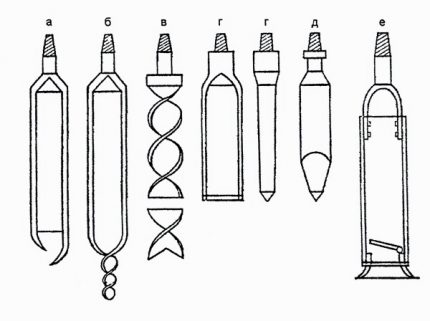
The integrity of the soil is violated by the cutting nozzles of the drill. They are made of durable three millimeter steel. The edges of the nozzles must be sharpened, given that the drill will rotate clockwise and destroy the soil as a result of rotational-translational motion.
First, choose a place to drill. In the soil we make a recess of about two bayonet shovels. So the guideline for the drill is dug out. Above the place where we entered the drill, you need to install a tower.
The height of the tower should correspond to the length of the drill rod: it should be slightly higher than this length. Only in this case, the bar can be easily and simply pulled out after completion of work.
Getting started will not seem difficult to you. The first turns of the drill quite easily enter the soil. One employee can cope with this task. But with further immersion in the ground with each turn, the drill goes harder and slower.
At this stage of work, an assistant is no longer necessary. If the drill has become difficult to lift to the surface, it should be turned counterclockwise, and then try again.
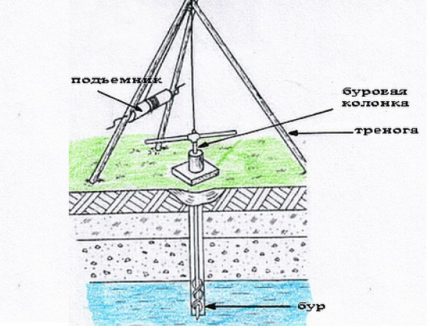
When subsequent deepening of the drill encounters significant resistance, there may be a risk of equipment breakdown. Therefore, you need to try to soften the soil using water for this purpose.
Work is ongoing, the drill is moving down, but do not forget that every half meter of its advancement it is necessary to free the tool from the ground, and for this you should lift it to the surface. When the tool is completely immersed in the soil on the handle, it must be increased with the next rod.
The entire drilling process takes a lot of time, most of which has to be spent on raising the drill to the surface and cleaning it from the ground. Therefore, it is worth using each cycle as efficiently as possible, trying to extract as much soil as possible.

If the layers that the tool passes are characterized by increased flowability, there is a danger of collapse of the well shaft at the most inopportune moment. To avoid this, casing pipes should be used to prevent the walls of the shaft from shedding.
But the state of the earth that comes to the surface has changed: the drill has reached the aquifer. There is very little left. Behind the aquifer should be waterproof. The drill must be immersed in the water-resistant layer so that the maximum amount of water enters the well. The maximum depth achieved by the manual drilling method is 10 to 20 meters. It is at this depth that, most often, the first aquifer is located.
First, dirty water rises to the surface, which is pumped out manually or submersible pump. To flush the well, it is enough to remove only a few buckets of dirt. If clean water is not in a hurry to change the dirty, you should drill another meter or two.
Like any other job, manual drilling can be upgraded using a hydraulic pump and an electric drill. You can perform such work even without helpers. The entire drilling process can be seen in this video.
Method # 2 - budget auger drilling
It is believed that it is auger, and not rotary drilling, that is the simplest and most financially affordable option for installing a well under water. It is the application of the screw method that is embedded in most modern small-sized drilling rigs.
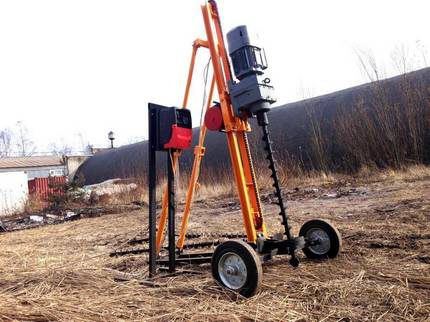
The screw is a screw known to all Archimedes. Those who at least once saw how fishermen are drilling a hole for ice fishing, imagine what is being discussed. In a similar way, a shallow well, up to 10 meters, is created. In the process, neither drilling fluid nor water is used, with which, in other cases, the tool is washed.
If you seek the help of a specialized organization, then most likely they will use screw drilling equipment in their work, which is easily transported and widely used.
A feature of this type of work is that it can not be performed on all types of soil. With the help of a screw you can’t pass rocks or quicksand, but on dry and soft sedimentary soils this method has proven itself perfectly. When performing this work, attention should be paid to protecting the mine from contaminated water from the surface of the soil.
Method # 3 - rotary drilling (for rock formations)
If the development is to be arranged in rocky soils, then a rotary method of drilling is used to create it. It is based on the use of a special drill pipe, which resembles a thin glass turned upside down with a cone-shaped bit crushing the soil along the lower edge.
Communications used in drilling pass through the pipe cavity. The hydraulic unit puts pressure on the bit, making its way into the rock. The mass of the pipe string complements the load.
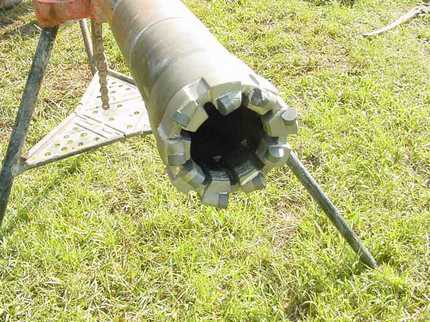
Soil is washed out of the well using a drilling fluid supplied into the pipe using one of two possible methods:
- Direct flushing. The solution is pumped into the pipe using a pump, and then flows through the annulus together with the rock.
- Backwash. The solution enters the pipe by gravity, and it is pumped out of the annulus together with the rock by a pump.
It is believed that backwashing is more effective than direct: with its help, a greater well production is achieved due to the highest-quality opening of the aquifer. But to implement this flushing method, it is necessary to use expensive equipment, which affects the increase in the cost of work. Direct flushing will cost less than reverse.
Method # 4 - shock-rope drilling
If you want to get a well that will last you up to 50 years and have enough time, effort and nerves to implement it, then choose a shock-rope method of drilling. It will take a long time to work. You will slowly but surely make your way to the cherished goal.
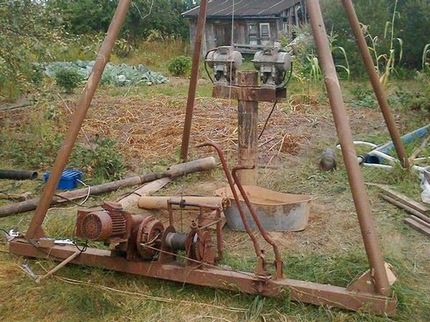
The process is based on the use of specific drill bit - baits. This is a section of a thick-walled pipe with a length of 1 to 2 m with a ball or flap valve at the bottom. In the upper part of the pipe, a “window” is cut out to extract the soil, the top is equipped with an eye under the torso.
Tied to a cable thrown over the block, the bailer is freely thrown into the face. Falling down, it loosens the soil and grabs it with a valve. The process is repeated several times before being removed from the trunk of the bobbin. Extracted from the well, the bailer is freed from the soil: they turn it over and shake it through the hole.
This method of punching a mine is considered very laborious, but effective. In addition, sands and loose sedimentary rocks saturated with water can be removed from the well only by the shock-rope method. Drilling fluid is not used for gelation, so groundwater that has appeared in the well cannot be confused with it.
Due to the high complexity, this method is more expensive than the rotary one. In addition, if the goal is to go beyond the first aquifer, you will have to bear the cost of isolating the mine from the aquifers that are located above.
For this, additional casing pipes are used. In addition to increasing the consumption of materials, the volume of work performed by specialists is also growing. Therefore, such a construction will cost a lot.
More information on how to drill water well without equipment, you can get by reading the article submitted by us.
Conclusions and useful video on the topic
The roller will visualize the process of manually drilling a well with the installation of a casing and a filter in the casing:
Each type of water well has its own advantages and disadvantages.
Now that you have an idea of the type of wells, their structure and construction methods, it will be easier for you to make a choice in favor of a particular design, based on the characteristics of your site and your own financial capabilities.
If you have ever drilled a well with your own hands, tell us about how complicated or simple the process was. Please write comments in the block below. Ask questions, share impressions, post pictures on the topic of the article.

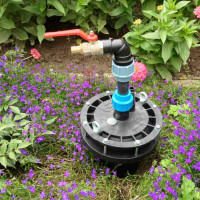 Do-it-yourself well in the country: a review of technology and tools for manual drilling
Do-it-yourself well in the country: a review of technology and tools for manual drilling  Do-it-yourself well without equipment: how to independently arrange a water source
Do-it-yourself well without equipment: how to independently arrange a water source 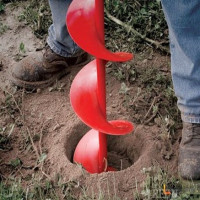 How to drill a well with your own hands: ways to budget independent drilling
How to drill a well with your own hands: ways to budget independent drilling  Do-it-yourself water-boring for water wells: a review of technology
Do-it-yourself water-boring for water wells: a review of technology 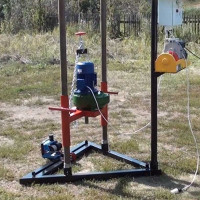 DIY drilling rig: making a homemade drill for drilling wells
DIY drilling rig: making a homemade drill for drilling wells 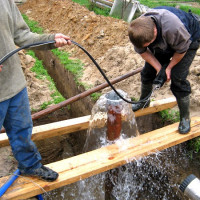 Do-it-yourself flushing of the well after drilling: step-by-step briefing on the work
Do-it-yourself flushing of the well after drilling: step-by-step briefing on the work  How much does it cost to connect gas to a private house: the price of organizing gas supply
How much does it cost to connect gas to a private house: the price of organizing gas supply  The best washing machines with dryer: model rating and customer tips
The best washing machines with dryer: model rating and customer tips  What is the color temperature of light and the nuances of choosing the temperature of the lamps to suit your needs
What is the color temperature of light and the nuances of choosing the temperature of the lamps to suit your needs  Replacement of a geyser in an apartment: replacement paperwork + basic norms and requirements
Replacement of a geyser in an apartment: replacement paperwork + basic norms and requirements
To begin with, before drilling, it would be nice to find out at what depth aquifers lie and decide what you need for a well: for watering, for swimming or drinking. And from here it is based on the choice of the depth of development and the method of its arrangement.
For casing pipes, take metal, or specially designed PVC pipes, but not those that are used in the laying of communications. Take the water that appears from the well to the SES for analysis to verify its suitability for drinking.
Can two men drill an artesian well? Amazing My task now is to drill a well in its area after dividing the total territory into two parts.
If the production will be at a distance of 5-10 meters from the already existing water intake point, does this mean that the flow rate in it will be equal and the water of the same quality? Will it then be necessary to take water samples for analysis?
What's so surprising? Better, of course, at least the three of us, it’s more convenient, but if there are no more people, then we can cope together. Of course, the number of drillers varies depending on the method.
If you are going to drill a well next to the old one into the same aquifer, then you probably can not do a new water analysis. But just by making the well so close, you run the risk of clogging the old, or even completely collapse, aquifer. In general, a well, in a good way, should be done at least 15 meters from the next one.
As for the flow rate of the well, it should not fall, it will be about the same level as in the first.